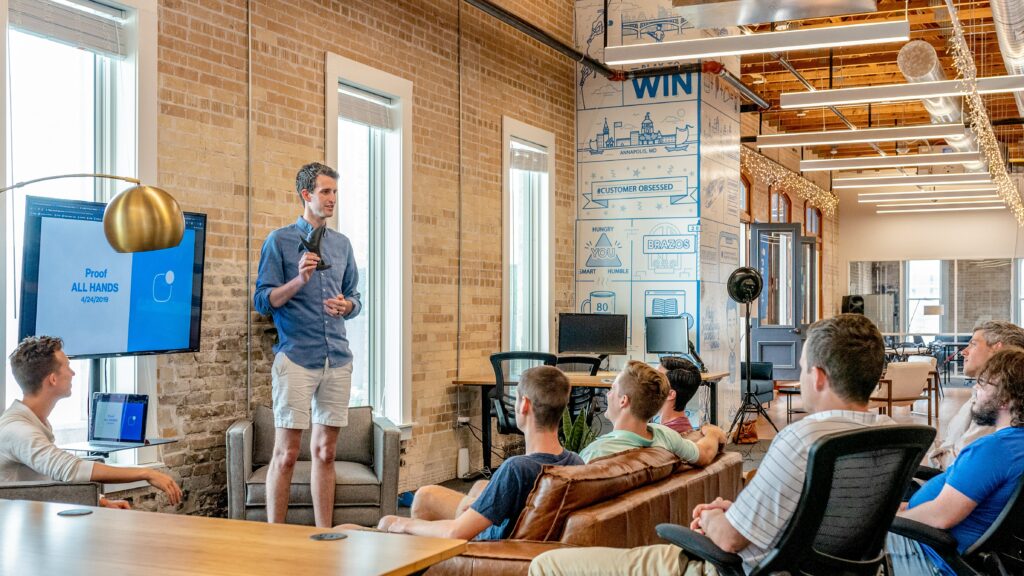
In collaboration with Splash
If you missed our article about activating collaboration during your offsite... start here first.
If your offsite isn’t focused on building employee connections between attendees, then all you’ve done is move your office to a hotel for a few days.
While I’m sure the office chairs appreciate the time off, one of the most important outcomes from any offsite is forming bonds between colleagues. I know it can be hard to directly measure connections between coworkers, but we’ve all seen the benefits to business impact when teams trust each other. Employee retention goes up, which is especially important these days. Projects get done faster, partly because there’s more cross-department collaboration. Even bureaucracy gets streamlined.
When you foster valuable connections at your offsite, you can reap the benefits once those office chairs are back on the clock. These connections are born from vulnerability, so your offsite needs activities and experiences that promote openness and the confidence required to be vulnerable in the first place. Based on experiences I and other event planners have had, I came up with five approaches — below — for easily and effectively creating connections through shared vulnerability.
— Ben Hindman, Founder & Head of Event Strategy, Splash

A 5-minute story can tell you more about a coworker than years of chit-chat in the break room. Get us telling stories, especially about ourselves, and we’ll bond together just like audiences form connections with their favorite movie characters.
Why? Because stories create empathy by making audiences see the world through another person’s eyes and experiences. The more we understand and empathize with our coworkers, the stronger the connections between us become. Understanding our teammates are the building blocks that lead to accomplishing our goals together better and faster. Here are some thought starters for using storytelling to increase connections during your offsite.
Examples of storytelling activities:
Team building, FTW!
Browse team building activities and vendors to help foster connection at your next offsite.
Remember that “child-like” doesn’t mean “childish.” The goal here is to be free of pretense or judgment, not immature. As adults, it can be hard to let loose and be silly. We rarely have the space and time to do things just to do them, without an agenda. There really is a sense of vulnerability in letting go and just being a kid again.
The idea here is to lose touch with our rational minds and just be in the moment. If you can get participants doing instead of thinking and creating purely for the sake of creation, then they can enter a more open state of mind at your offsite.
Examples of freeing, child-like activities:

Making the right connections starts with being in the right environment. It’s a big reason why this is an offsite away from the usual office vibe, after all. Sitting two people down and demanding they TALK NOW usually doesn’t lead to productive conversations, especially if these folks don’t know each other yet.
Help attendees feel their freest by creating chat-friendly activities and spaces, including a mix of cozier spots for just a few people and places where groups can mingle. Shaping the environment for your offsite will lead to more meaningful and connected conversations.
Examples of chattable activities:
You know how you can’t help but smile when hearing someone get happy and excited about something? Every person in your organization is passionate about something, and that enthusiasm is contagious. Unearth these passions and you’ll find everyone is drawn into the conversation and eager to participate.
Maybe some colleagues are passionate about the latest programming language. Others can’t get enough of cooking. Personally, I’m big on science and roller skating, myself. Whatever inspires and drives us, it’s powerful to capture these feelings and share them with each other.
Examples of passion-centric activities:
Just because you’re planning the offsite doesn’t mean you have to do it all alone. In fact, having attendees contribute during the planning phase helps increase their sense of ownership and connection with the upcoming event itself. Who wouldn’t want to attend a party they’re helping to bring to life?
Start bringing in others early and solicit input and help from as many team members as possible. A great offsite experience is a gift, and giving gifts feels great, so allow everyone the opportunity to share in that feeling.
Examples of collaboration activities:
True connection requires vulnerability, and being vulnerable can feel scary. As a fellow planner, I know you might be hesitant to ask your team (and yourself) to be vulnerable. If something goes wrong, people could get upset.
Like the time I organized a dodgeball tournament and someone came up to me afterwards because she was mad at me. She cried while telling me how the event conjured up challenging middle school memories for her. When I started apologizing to her, she stopped crying and let me know that ultimately, this was a good experience for her because the dodgeball tournament gave her an opportunity to explore long dormant thoughts. In that moment of vulnerability, she was able to talk with colleagues about what she was feeling and lean on others to work through it. As a result, this woman went from being vulnerable to being more connected to her coworkers than ever before.
While vulnerability is scary, you can create spaces where it’s safe to be vulnerable together. To help with that, I suggest making vulnerability-focused activities opt-in only so no one gets caught unaware. It also helps to actively facilitate non-judgmental and supportive reactions. Because if your offsite is a safe place to be open with each other, the connections that form can reach across the entire company long after the free beer runs out.
P.S. For real, don’t forget the free drinks. Those are super important. Name tags, too.
Don't forget your remote employees!
Book a virtual team building activity that motivates and inspires.